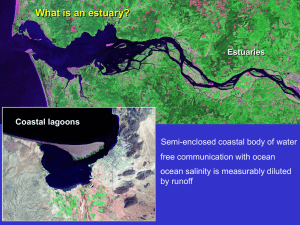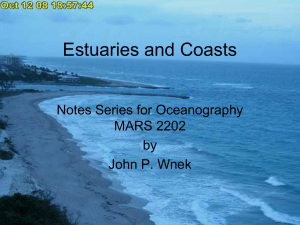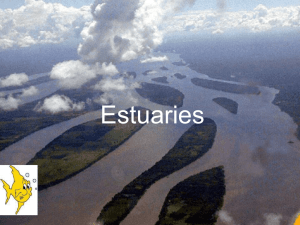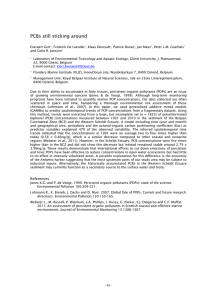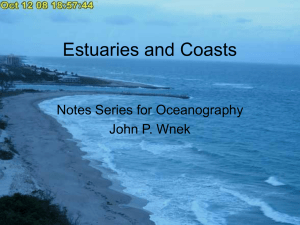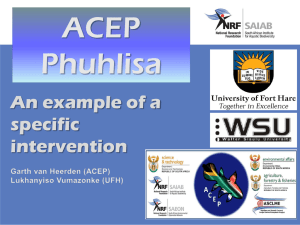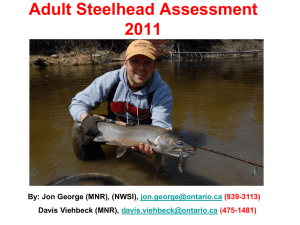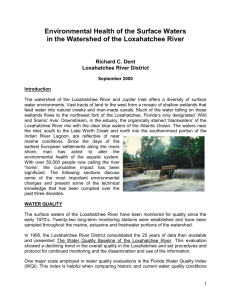Presentation ()
advertisement
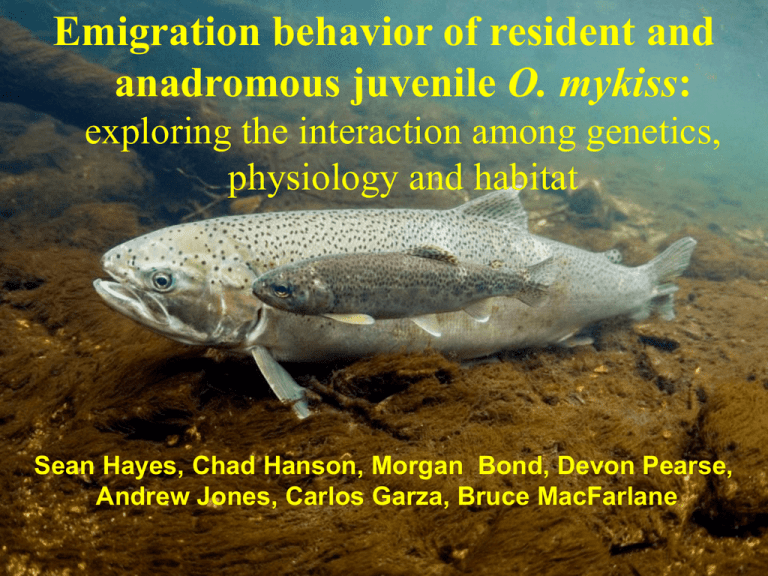
Emigration behavior of resident and anadromous juvenile O. mykiss: exploring the interaction among genetics, physiology and habitat Sean Hayes, Chad Hanson, Morgan Bond, Devon Pearse, Andrew Jones, Carlos Garza, Bruce MacFarlane Scott Creek •Small watershed (75km2) •23km of stream accessible to anadromous fish •“native” resident fish above barriers •Small hatchery •Dynamic flow regime (28m3 s-1 to 0.1m3 s-1) •Small Estuary (closes seasonally) Map: Rob Schick, NMFS Scott Creek O. mykiss life history strategies Ocean upper watershed estuary/lagoon Upstream resident Mature in estuary (never enter ocean) Scott Creek Instream PIT tag readers x x x Smolt trap X= barrier 3 km Adult weir Seine, hook & line, and electrofishing Do rainbow trout and steelhead differ? Big Creek Above Big Creek, Boyer Scott Creek Above Mill Above 68 63 Resident populations “diverged” >100 yrs ago 92 76 Big Creek Adults 60 Scott Creek Adults Hatchery Juveniles Weir Adults Lagoon Juveniles Neighbor-Joining distance tree, with bootstrap values for supported nodes ? x x x Proportion of fish assigned to Resident or Anadromous ancestry by habitat 100% 90% 80% 70% Anadromou 60% Resident 50% 40% 30% 20% 10% 0% Above Barrier Upstream Smolt trap Estuary Frequency 0.40 0.30 Genotype distribution in upper watershed Resident (n=128) Anadromous (n=209) 0.20 0.10 0.00 Fork length Emigration rate from above anadromy barrier • 400 fish PIT tagged above • 2.3 % over the falls • 1.8 % detected at smolt trap + Na 6 Physiology ? 8 Above Barrier Upstream ATPase activity ATPase activity 8 + K -ATPase 4 2 0 6 Smolt Trap Estuary 4 2 0 Jan Feb Mar Apr May Jun Jul Aug Sep Oct Nov Dec Jan Feb Mar Apr May Jun Jul Aug Sep Oct Nov Dec + Na + K -ATPase Physiology Upstream samples Resident Anadromous 6.00 4.00 2.00 0.00 0 2 4 6 Month 8 10 Frequency ATPase 8.00 12 Resident Anadromous 6 4 2 0 0 2 4 6 8 10 ATPase 12 14 16 Why do wild fish migrate at such small sizes? Frequency 0.16 Typical steelhead smolt size distribution 0.12 0.08 0.04 0 Fork Length (mm) Does estuary serve as nursery habitat? (Morgan Bond’s thesis) Estuary- Open to Ocean (Jan.-June) Lagoon- Sand Bar Closed (July-Dec.) Is the estuary a nursery? Black lines indicate upper watershed growth Blue lines indicate migration to estuary and growth Fork Length (mm) 250 200 Size threshold for ocean survival 150 100 Mean 5th % 95th % 50 0 Jan YOY Jul 1+ Jan Jul 2+ Jan Jul 3+ Jan Jul Jan 85% of returning adults use estuary pathway Ocean upper watershed estuary/lagoon What happens when water quality degrades? >45% detected moving Upstream each fall (probably >90%) 3 km Size of recaps at smolt trap in spring 20 18 16 Upstream Estuary (previous summer) Frequency 14 12 10 8 6 4 2 0 60 80 100 120 140 160 180 200 Fork Length 220 240 260 280 300 A tale of two watersheds (in Central California…) No estuary available Year 1 Year 2 Year 3 Functional estuary present Year 1 Year 2 Year 3 Acknowledgements Funding • • • • NMFS DFG FRGP NURP California Sea Grant Land Owner support •Big Creek Lumber Company •The Wilson Family •Monterey Bay Salmon and Trout Project •Cal Poly Swanton Ranch •Lockheed Martin Implications of resident trout studies • Should residents be counted in steelhead populations for delisting criteria? • Residents may become steelhead, but this probably happens at low frequencies • Results of resident contribution to anadromous breeding pending Estuary Environmental Conditions “Lethal” levels Influence of genotype on To seamigration or not to behavior sea? Genotype Frequencies 1 Frequency Resident 0.8 Anadromous 0.6 0.4 0.2 0 Upstream Smolt trap Steelhead in Scott Creek Typical spring downstream migrant (smolt?) After 5-6 months rearing in estuary 85% of returning adults use estuary pathway 100mm Big smolts are less likely to stay 25 20 15 10 5 0 < <150 >150 Fork Length (mm) at Trap Conclusions Central Coast steelhead adapt for estuarine use Steelhead strategies without estuary • Longer upstream rearing • Fewer smolts, reduced anadromy? Density-dependent Estuary Growth in Steelhead Figure 5. Estimated lagoon yearly population sizes and yearly mean growth rates from 2003-2006 (left y-axis). The bar graph (right side y-axis) represents mean fork length of fish sampled in the estuary in late fall of each year, just prior to winter storm season and lagoon opening. Years match points within labeled column. All data are means ± SE, R2=0.99. Regression P= 0.005 SGR length as a % per day 1.0 2004 2005 0.8 0.6 0.4 2003 2006 0.2 0 500 1000 1500 2000 2500 Estimated Lagoon Population 3000 Implications for Local Rivers • Larger river- may have more rearing capacity= larger smolts upstream • BUT… is there enough water? • Estuary issues – Breaching – Estuary size reduced? – Enough flow to connect with watershed? Lagoon fish move upstream in the fall and then back down in spring Lagoon fish PIT tag reader detections 350 >45% lagoon fish detected moving upstream 300 Upper watershed Frequency 250 Lower watershed 200 150 100 50 0 Jan Feb Mar Apr May Jun Jul Month Aug Sep Oct Nov Dec Early 20th century spawning population was 4-10 times larger Escapement ?? Why is estuary growth so good? (Jeff Harding’s diet studies) Lots of food! Diet consists of Corophium and Eogammarus sp. But where does food come from? • • • • Upper watershed growth poor Insect diet Low flow Low light – low nutrient input into estuary Hypothesis- Nutrient flow from marine derived nutrients (kelp) enhances productivity Marine (Alison Collins senior thesis) 13C and 15N from Juvenile Steelhead d15 N (0/00) +/- SD 16 14 12 10 Juv. Steelhead - Lagoon Juv. Steelhead - Above Fall 8 Adult Steelhead 6 Coastal Marine Fish -26 Terrestrial -24 -22 -20 d13 C (0/00) +/- SD -18 -16 -14 Marine Why don’t all fish recruit to the estuary?

